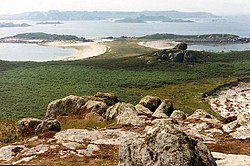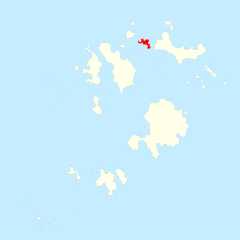Teän: Difference between revisions
Created page with '{{Infobox island|name=Teän |county=Cornwall |group=Isles of Scilly |picture=Tean, Isles of Scilly. View from the Great Hill - geograph.org.uk - 260948.jpg |picture caption=Teän…' |
mNo edit summary |
||
| Line 4: | Line 4: | ||
|picture=Tean, Isles of Scilly. View from the Great Hill - geograph.org.uk - 260948.jpg | |picture=Tean, Isles of Scilly. View from the Great Hill - geograph.org.uk - 260948.jpg | ||
|picture caption=Teän, from the Great Hill | |picture caption=Teän, from the Great Hill | ||
|map=Tean island Scilly.svg | |||
|os grid ref=SV908164 | |os grid ref=SV908164 | ||
|highest point=Great Hill, 131 feet | |highest point=Great Hill, 131 feet | ||
Latest revision as of 16:07, 29 February 2012
| Teän | |
 Teän, from the Great Hill | |
|---|---|
| Location | |
| Grid reference: | SV908164 |
| Highest point: | Great Hill, 131 feet |
| Data | |
Teän (sometimes written Tean without the diaeresis) is one of the uninhabited islands to the north of the Isles of Scilly and lies between Tresco, a mile to the west and St Martin's 300 yards to the east.
Approximately 40 acres in area the island consists of a series of granite tors with the highest point, Great Hill, rising to 131 feet at the eastern end. The low lying land is overlain with glacial till and outwash gravels with glacial erratics abundant on the north coast beaches which indicates the southern limit of outwash from an ice sheet[1] for which it is designated a Geological Conservation Review site.[2]
There is evidence of occupation from the Bronze Age to the early 19th century and the island was still being grazed in 1945.[3] An early Christian chapel exists on the island, it is possibly named after a Saint Theon.
The island lies within the Isles of Scilly Heritage Coast, and is in the Isles of Scilly Area of Outstanding Natural Beauty and managed by the Isles of Scilly Wildlife Trust which has an Higher Level Stewardship (HLS) agreement.
History
The coastline of Teän consists of a number of bays and sandy beaches which link to offshore rocks and carns at low tide. The western part of the island has low lying ground linking granite carns, and field boundaries from the Romano-British period can be seen at extreme low tides.[3] One of the carns, Old Man, has an early structure, a Bronze Age entrance grave, as does Great Hill in the east of the island. Roman type brooches have been found in a grave on Old Man.[4] Sixteen early Christian graves have been found under the east wall of St Theona's chapel which was built later on top of the graves. There was probably an earlier wooden chapel.[5]
A Parliamentary survey of 1652 reported one man living in a ruined house on the island[6] and, in 1684, there was a thatched cottage between East Porth and West Porth which belonged to a Mr Nance who introduced kelp burning to Scilly. His family continued to live on Teän for several more generations and by 1717 there were ten people living on the island, but in 1752 William Borlase only saw fields of corn and ruined buildings.[3] In the 19th century Woodley reported occasional occupation, a few acres of cultivation and sheep grazing.[7] Cattle were still being grazed in 1945.[8]
Natural history
The island was first notified as a Site of Special Scientific Interest in 1971 and re-notified in 1986 under the 1981 Act. The SSSI was last assessed on 8 September 2009 and was found to be favourable. The assessment found that the vascular plant assemblage was all recorded apart from four-leaved allseed (Polycarpon tetraphyllum). A key issue was lack of management for orange bird’s-foot (Ornithopus pinnatus) which needs short turf, and can be addressed with the HLS agreement held by the Isles of Scilly Wildlife Trust.[1]
Flora
Human activity continued until relatively recent and is evident with 20 acres of the island surrounded by hedges and once cultivated. This area, with deeper soils, is dominated by bracken and still has relic pasture plants such as rye grass, red clover, hop trefoil and black knapweed. The maritime grassland around St Helen's Porth, and on the south coast, has abundant thrift and sea campion, and near Clodgie Point orange bird’s-foot occurs. The dune grassland area behind East and West Porth is important for the very rare dwarf pansy (Viola kitaibeliana). The summit of Great Hill has a small area of lowland heath.[1]
Rare plants
- Shore dock (Rumex rupestris) first recorded here in 1984 and still there in 2005.
- Four-leaved allseed (Polycarpon tetraphyllum) last recorded in 1990
- Saltwort (Salsola kali) recorded in 2009, once found on most sandy beaches in Scilly and now a rare plant; previous record on Scilly was 2004 on Samson.[9]
Fauna
The only mammals found on Teän are the Brown Rat and the House Mouse.[3] Rabbits may be extinct, and with no grazing animals on the island, plants that prefer a short sward such as orange bird’s foot may become extinct.
In 1850 J. W. North reported that Teän "is a preserve of white rabbits"![10] Scilly Shrew bones have been found in Roman or early mediæval middens and it was last recorded in 1964. There are no recent records.[3]
Breeding birds
The SSSI citation lists five species of breeding birds on the island including the Puffin. Other breeding seabirds are the Kittiwake, Herring Gull, Lesser Black-backed Gull and a small number of Greater Black-backed Gull. The seabird breeding colonies are in decline on the Isles of Scilly and in the years 2006–09 the Kittiwake has failed to breed on all the islands bar one chick raised on St Agnes in 2009. Of the species listed above, none have been recorded as breeding on Teän in 2009.[11]
A pair of Marsh Harriers (Circus aeruginosus) bred on Teän in 2008 and two juveniles were seen.[11]
References
- ↑ 1.0 1.1 1.2 "Teän". Natural England. http://www.sssi.naturalengland.org.uk/citation/citation_photo/1002053.pdf. Retrieved 13 September 2011.
- ↑ "The Isles of Scilly Natural Area". Natural England. http://www.naturalareas.naturalengland.org.uk/Science/natural/profiles%5CnaProfile113.pdf. Retrieved 16 December 2011.
- ↑ 3.0 3.1 3.2 3.3 3.4 Parslow, R. (2007) The Isles of Scilly. New Naturalist Library. London: HarperCollins
- ↑ Gray, A.; Ashbee, P. (ed) (1972). Prehistoric Habitation Sites on the Isles of Scilly. 19–49.
- ↑ Reid, N. (2007) Isles of Scilly Guidebook.
- ↑ Thomas, C. (1985) Exploration of a Drowned Landscape: archaeology and history of the Isles of Scilly. London: Batsford
- ↑ Woodley, G. (1822) "A View of the Present State of the Scilly Islands". London. In: Parslow, Rosemary (2007) The Isles of Scilly. (New Naturalist Library.) London: Collins ISBN 000220150X
- ↑ Geoffrey Grigson|Grigson, Geoffrey (1948) "The Scilly Isles". London: Paul Elek. In: Parslow, Rosemary (2007) The Isles of Scilly. (New Naturalist Library.) London: Collins ISBN 000220150X
- ↑ Parslow, R. (2010). Plant Records for 2009.
- ↑ North, J. W. (1850). A Week in the Isles of Scilly. London: Longman & Co.
- ↑ 11.0 11.1 Hudson, D (ed.) (2010). Isles of Scilly Bird and Natural History Review 2009. Isles of Scilly Birdgroup.
Outside links
| ("Wikimedia Commons" has material about Teän) |
- Lowland heathland - a cultural and endangered landscape
- The Isles of Scilly Area of Outstanding Beauty
- The Isles of Scilly Wildlife Trust
| Isles of Scilly |
|---|
|
St Mary's •
St Agnes •
Tresco •
Bryher •
St Martin's •
Gugh
|

